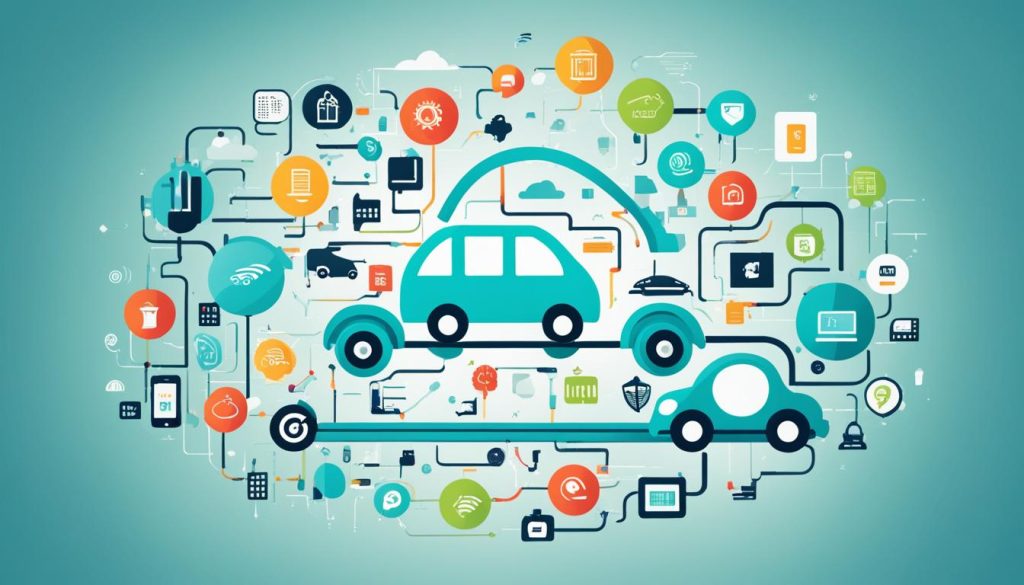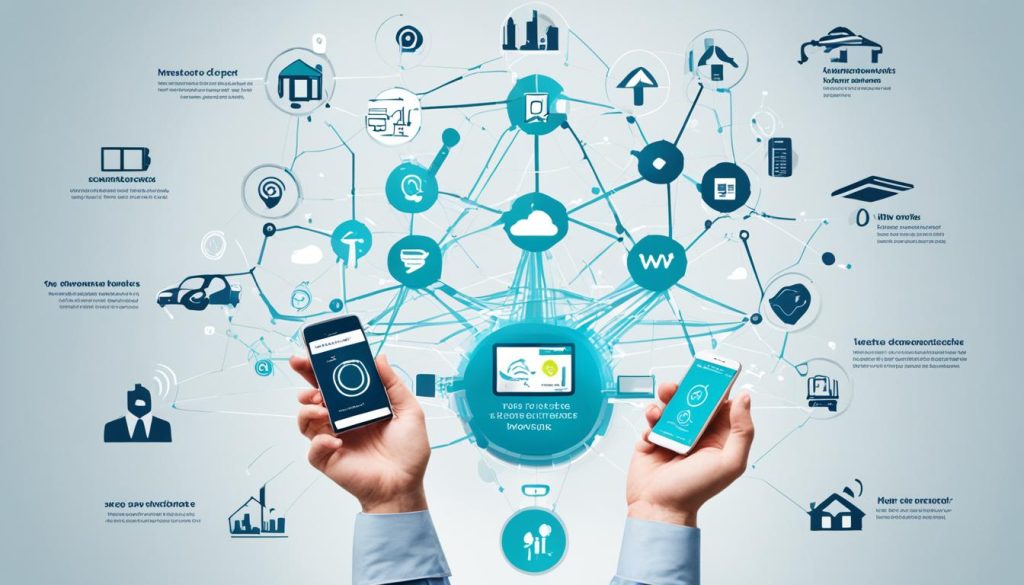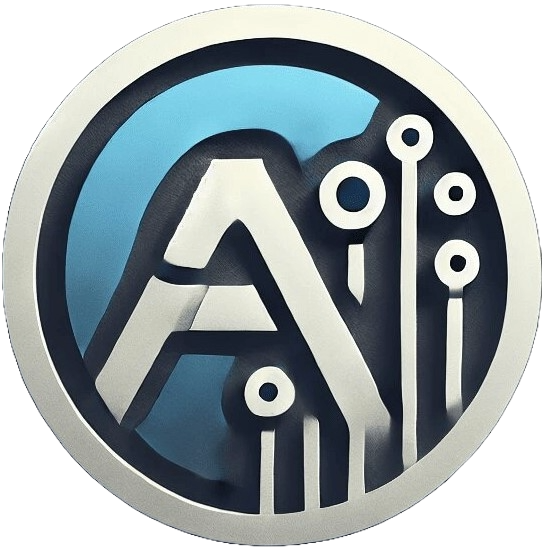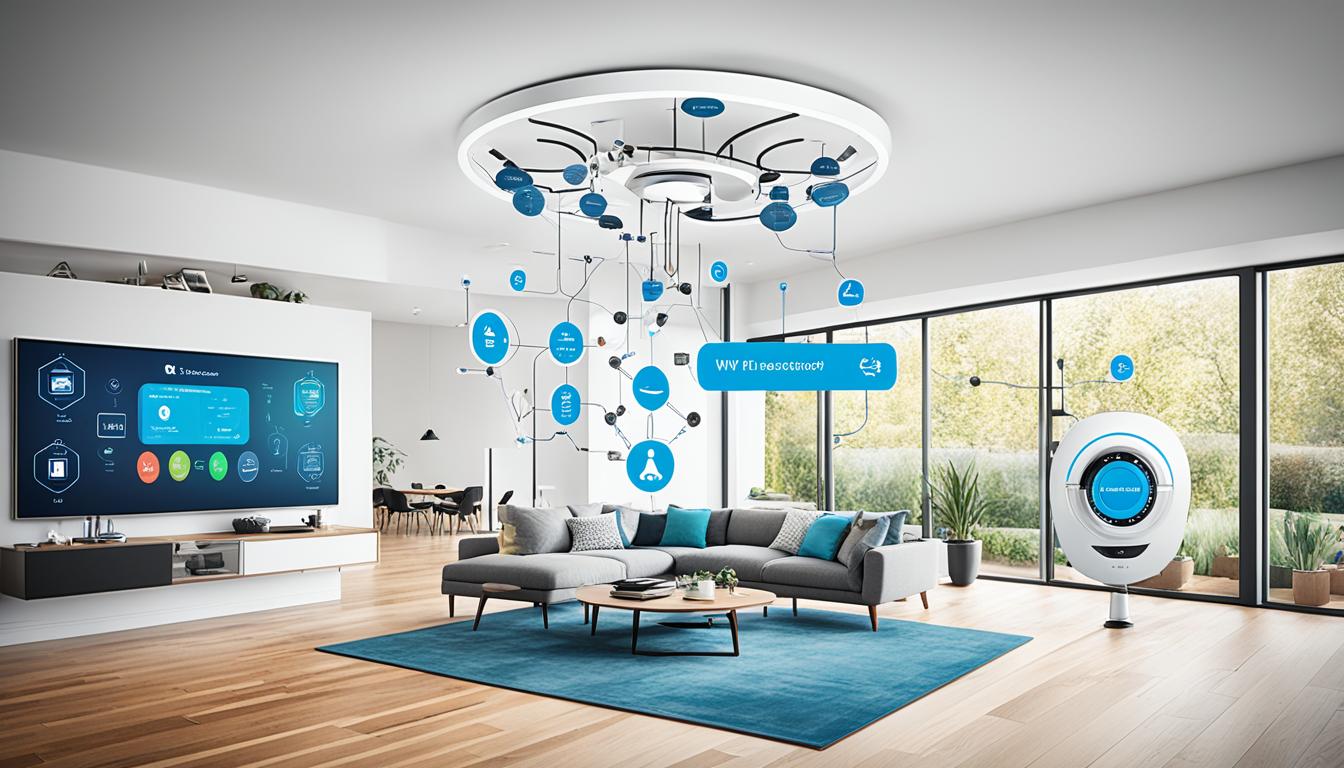Did you know that by 2025, the Internet of Things (IoT) will be worth a huge $12.6 trillion? Also, over 30.9 billion devices will connect to the internet12. The IoT is changing how we interact with the world. This guide will help you understand what IoT is, including its devices and technology.
In today’s digital world, IoT devices are everywhere, from smart homes to industrial settings. With more people buying wearables and smart home tech, 70% of first-time buyers plan to get more1. This guide will give you key insights into the IoT world. It will cover its evolution, uses, and what the future holds, keeping you updated in a connected world.
Key Takeaways
- The economic value of IoT will reach about $12.6 trillion by 2025.
- Over 30.9 billion devices will be connected to the Internet by 2025.
- IoT technology revolutionizes personal and business connectivity.
- Wearables track fitness data and have potential health applications.
- 70% of consumers are likely to purchase more smart home devices.
Introduction to the Internet of Things (IoT)
The Internet of Things (IoT) marks a big change in technology. It’s a network of devices that talk to each other over the internet. Today, over 7 billion devices are connected, and this number could hit 22 billion by 20253. IoT touches many areas, making things work better and improving how we experience them. Companies use IoT to work smarter and add more value4.

IoT shows up in our daily lives with smart home gadgets, fitness trackers, and connected cars. It makes things easier and safer for us. In healthcare, IoT helps by tracking patients, managing medical equipment, and keeping track of supplies5. Other sectors like manufacturing, transport, and retail use it too. They benefit from predictive maintenance and better data analysis5.
Getting to know IoT basics is key as it changes how we interact with the world. It connects devices through sensors and technology, leading to big savings and better decisions4. This helps not just users but also drives change in many industries. It shows IoT’s big role in our future.
| Industry | IoT Applications | Benefits |
|---|---|---|
| Manufacturing | Machine performance monitoring, production optimization | Reduced downtime, improved efficiency |
| Transportation | Vehicle performance tracking, route optimization | Cost savings, improved freight management |
| Healthcare | Patient monitoring, asset tracking | Enhanced patient care, inventory efficiency |
| Retail | Inventory management, customer behavior analysis | Optimized supply chain, improved customer experience |
What is the Internet of Things (IoT)?
The Internet of Things (IoT) is a network of devices that talk to each other over the internet. These devices can send and receive data, making things work better and more efficiently. It’s important to know what IoT is to see how it changes our lives in many ways.

Understanding the IoT Definition
The IoT includes devices that talk to each other over networks. The term “Internet of Things” was first mentioned in 1985 and became popular in 1999 by Kevin Ashton. These devices help in many areas, from smart homes to big industries, but they also raise privacy and security concerns6.
Now, one in three Americans uses a fitness tracker, showing how IoT devices are becoming part of our daily lives7. The IoT could be worth $12.5 trillion by 2030, showing its big impact on the economy7.
Characteristics of IoT Devices
IoT devices can send and receive data on their own, which helps with real-time analysis. They have sensors, can communicate, and process data. These devices form big networks that make industries work better.
For example, IoT helps with home automation and makes factories more productive7. IoT has many uses, like in healthcare, safety, and managing energy7.
The IoT could add $3.3 trillion to factory productivity by 2030, showing its big role in manufacturing7.
The History of IoT
The history of IoT is filled with big steps and key moments that have shaped it. Knowing where IoT started helps us understand its huge impact today. It’s all about billions of devices talking to each other through networks like Ethernet, Wi-Fi, and Bluetooth8. Kevin Ashton first used the term IoT in 1999, showing how it could change things like supply chain management9.
Origins and Evolution of IoT
IoT started in the 1950s with early computer work, setting the stage for what came next9. The internet’s growth from ARPANET in 1969 helped IoT grow. Big steps like the launch of GPS in 1993 made the Industrial Internet of Things (IIoT) better9. By 2010, IoT was all about making industries more efficient with smart sensors and tech like MEMS9.
Key Milestones in IoT Development
Many important events have shaped IoT’s path. By 2015, smartphones were key to IoT, helping with marketing and health tracking9. Self-driving cars started in the 1980s, showing the goal of making driving automated9. Today, with about 35 billion devices out there, IoT’s growth shows its big impact on many areas8.
Examples of IoT
The Internet of Things (IoT) is changing how we live and work. It brings new tech into our daily lives and helps make things run smoother in many areas.
Consumer IoT Devices
Consumer IoT includes gadgets you use every day, like smart home tech and fitness trackers. Big names like Amazon, FitBit, and others add IoT features to their products. This makes life easier and more convenient for us.
For example, smart home devices can do lots of tasks on their own. You can control things like lights and the climate with just your voice or a smartphone app. By 2025, we’ll have around 27 billion connected devices, showing how popular IoT is getting10.
Industrial IoT Applications
Industrial IoT (IIoT) is changing how we make things and manage resources. It makes factories work better, safer, and more precise. Companies like John Deere use IIoT to keep an eye on things like soil moisture and temperature in farming.
Verkada’s systems let us watch over buildings and keep an eye on the environment with cameras and sensors. This shows how industries are moving towards smarter buildings10.
Infrastructure IoT Technologies
Infrastructure IoT is making cities and rural areas better. It helps us manage things like traffic, energy, and safety in real-time. For example, Enevo uses IoT sensors to make waste management better by tracking when dumpsters need to be emptied.
Companies like AGCO have smart farming tools that help farmers use resources wisely and make better choices. This shows how IoT is key to creating smarter infrastructure11
The Internet of Things Ecosystem: How Does it Work?
The IoT ecosystem is made up of many parts that work together. These parts include sensors, Wi-Fi and Bluetooth for connectivity, and tools for analyzing data. By 2030, the number of IoT devices is expected to jump from 9.7 billion to 29 billion12. This shows how fast this field is growing.
This setup helps automate many processes, making things run smoother and more efficiently. For example, IoT sensors track how well machines work, helping to fix problems before they cause big issues13. It also helps manage resources better, like saving energy and water, which saves money and is good for the planet13.
As more people use IoT, spending on it is set to hit $1.2 trillion by 202512. This shows how valuable IoT has become, leading to new ways of doing business14. With better networks like 5G, IoT devices and services will get even more powerful14 and13.
Sensor Technology & IoT
Sensor technology is key to the Internet of Things (IoT). It lets devices send and receive data for better decisions. IoT sensors are crucial, measuring things like temperature and motion. This info helps improve many areas, showing how vital IoT sensors are.
The Role of Sensors in IoT
Sensors play a big part in collecting and managing data in IoT. They make real-time monitoring and predictive analytics possible. For example, temperature and motion sensors in smart buildings save energy and keep people safe. With new sensor tech, there are active and passive sensors for different needs.
Types of Sensors and Their Applications
Many sensor types are used in IoT. Here’s a table showing some sensors and where they’re used:
| Sensor Type | Application |
|---|---|
| Temperature Sensors | Monitoring climate in smart homes and agriculture15. |
| Motion Sensors | Security systems and smart lighting15. |
| Air Quality Sensors | Tracking pollution levels for cities15. |
| Biomedical Sensors | Wearable health devices for monitoring vital signs15. |
| Pressure Sensors | Real-time monitoring of water systems15. |
This table shows just a few ways sensor technology is used in IoT. As industries grow, we’ll depend more on sensors for smart systems.
Benefits of Sensor-Based IoT
Sensor-based IoT systems are changing the game in many industries. They make things more efficient and productive, and they save a lot of money. By automating processes, businesses can run smoother and use less manual labor.
Improving Efficiency and Productivity
Adding IoT automation to businesses can really boost productivity. For example, in healthcare, IoT sensors keep an eye on patients’ health from afar. This lets doctors act fast and improve care quality16. In factories, IoT sensors help make decisions based on data, making things run better17.
In farming, IoT helps by making farming smarter. It watches over soil and weather, leading to better crops and less waste18.
Cost Savings through Automation
Using IoT can save a lot of money in many areas. For instance, logistics can save money by using resources better and wasting less. Cheap sensors and RFID tags are making IoT more affordable for businesses17. In the food world, IoT sensors keep food safe and track it through the supply chain. This cuts down on losses and makes things more transparent16.
With new tech like 5G, companies can use even more sensors. This means more efficiency and savings from IoT17.
IoT Security Challenges
The rapid growth of Internet of Things (IoT) technology brings big security challenges. Billions of IoT devices online mean more complexity in keeping them safe. These devices offer many ways for IoT vulnerabilities, like weak passwords, outdated software, and insecure ways of talking to each other.
Understanding IoT Vulnerabilities
Studies show many IoT vulnerabilities that make things risky. For example, most IoT device traffic is not encrypted, which means sensitive data is at risk19. Many devices come with default passwords, making them easy targets for hackers20. Problems like not testing enough, weak firmware, and patching issues also make it hard to protect IoT devices1920.
Best Practices for IoT Security
To keep IoT devices safe, we need to follow best practices made for this tech. Companies should update software regularly to fight off IoT vulnerabilities21. Using strong encryption for data moving and stored is key to keeping info safe19. Also, strong access controls, like multi-factor authentication and digital certificates, can protect devices from unauthorized access19. Knowing about IoT security challenges helps companies build a strong security plan. This leads to safer online interactions and helps follow the law.
IoT Connectivity Explained
Understanding IoT connectivity is key to making sure your devices talk to each other well. Around the world, 94% of companies are looking into or using IoT technology22. Good connectivity lets devices work together, making decisions based on data to improve how things run22.
There are many IoT wireless protocols used to connect devices. Popular ones include NB-IoT, LTE-M, Cat-M1, and Wi-Fi, each with its own benefits for different uses23. Choosing the right tech means thinking about coverage and energy use. This affects how long the battery lasts and how devices work in different places24.
Three key things affect IoT connectivity choices: coverage, energy use, and how fast data moves24. You need coverage that reaches everywhere, from inside buildings to far-off areas. This shows why picking the right solution is important for your needs24. It’s also vital to look at the strengths and weaknesses of each IoT tech, like how they handle moving devices and data speed24.
Data speeds vary a lot in IoT, from slow for simple tasks to fast for things like video24. As more devices join the network, it’s key to pick a tech that can handle lots of connections in one area24.
| IoT Protocol | Data Rate | Coverage | Power Consumption | Typical Use Cases |
|---|---|---|---|---|
| NB-IoT | Low | Wide Area | Low | Smart Meters |
| LTE-M | Medium | Wide Area | Medium | Wearable Devices |
| Wi-Fi | High | Local | High | Smart Homes |
| LoRaWAN | Low | Wide Area | Very Low | Agricultural Sensors |
In summary, connecting IoT devices needs careful thought on many factors, like data speed and protocols. This choice affects how well your IoT setup works242322.
The Future of the IoT Ecosystem
The future of IoT is bright, with big changes coming our way. We expect to see over 41 billion IoT devices by 2025, showing how big this change will be25. These devices will help us in many areas, like healthcare, farming, and making businesses run better26.
Predictions for IoT Growth
Looking ahead to 2024-2025, we’ll see big steps in healthcare, like monitoring patients remotely and using telemedicine26. Factories will get smarter, saving money and running better. And with 5G networks, devices will connect faster and more reliably, making them work better together26.
Impact on Daily Life and Businesses
IoT is changing our daily lives, making things like appliances smarter and more efficient. It’s also changing IoT in business, helping companies make better decisions and offer unique experiences to customers26. IoT will also change how we move things around, saving money and improving service26. Adding AI to IoT will bring even more innovation, making smart choices and changing many industries.
Conclusion
The Internet of Things (IoT) has changed how we live and work, making our lives more connected. It started with machine-to-machine (M2M) communication and has grown into a network of smart devices. These devices make things more efficient and help us stay connected27.
IoT has big benefits for businesses and our daily lives. It helps businesses save money, use resources better, and make customers happier. As IoT grows, it will open up new ways for us to connect and improve our lives27.
But, with IoT’s growth comes challenges. We need to make sure our systems are safe from threats. This is key to keeping our devices secure and our information safe28.
In short, IoT brings both good and bad. By understanding its impact, we can navigate this digital change better. This leads us to a smarter, more efficient future.


